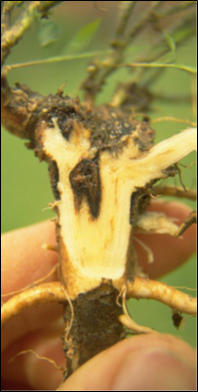Crown and Root Rot Complex in Alfalfa
Crown and Root Rot Complex
Symptoms
Infected plants are stunted with bleached, yellow leaves that wilt under moisture stress. Reddish to black rotted areas develop anywhere in the crown and upper tap root. Generally rot extends from the crown toward the roots and sometimes the crown is hollowed. The rot commonly develops slowly, but rapid development of crown rots can follow a series of stresses on the stand.

Crown Rot (unknown source)
Cause
Some root and crown rot complex can be found in most alfalfa plantings. Most damage is confined to aging stands, or stands weakened by other biological, environmental or cultural stresses. Weeds easily invade areas with the disease. Fields pastured or harvested while wet often have a higher incidence of the disease.
Other Crown and Stem Rots include Anthracnose, Sclerotinia Crown and Stem Rot, and Phytophthora Root Rot.
IPM Techniques
- Examine plants in the field every four weeks from April 1 to October 1. Examine suspicious plants within 100 feet of the monitoring site.
- Use varieties with a history of good performance in University of Kentucky alfalfa variety trials.
- Minimize crown injury by avoiding traffic or grazing when soil is wet.
- Maintain good soil fertility, especially potash.
- Allow adequate regrowth between cuttings.
- Allow 4-6 weeks between last harvest and freezedown.
- Control leafhoppers and other insects.
- Rotate away from forage legumes for two or more years.
References and Additional Information
- IPM-1 Kentucky Alfalfa IPM Manual
- PPA-10d Kentucky Plant Disease Management Guide for Forage Legumes, P. Vincelli, Extension Plant Pathology, University of Kentucky
- ID-104 Managing Diseases of Alfalfa, P. Vincelli, Extension Plant Pathology, and G.D. Lacefield and J.C. Henning, Agronomy, University of Kentucky
- PPFS-41 Crown Rots of Alfalfa, P. Vincelli, Extension Plant Pathology, University of Kentucky
- Compendium of Alfalfa Diseases. 2nd ed. Stuteville, D.L. & D.C. Erwin, (eds.). 1990.


